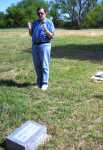Dowsing for the Dead -- Genealogist searches out of respect for sacrifices of the pioneers

He doesn't know why it works. He just knows it does. It's not witchcraft. It's not black magic, or "the work of the devil."
He does it with respect, out of respect for those who have gone on before him ... those who are lying in graves unmarked for one reason or another.
Tom Corey of McCook "dowses" for graves because of his interest in genealogy and history, and because of his respect for the lives and sacrifices of his ancestors.
On a Wednesday afternoon before Memorial Day, Tom and his wife, Nancy, located unmarked graves at Boxelder Cemetery, the small pioneer cemetery northeast of McCook that Boy Scout Troop 147 is cleaning up.
"You're gonna find unmarked graves," Corey said. "It's unfortunate."
A pioneer grave would generally be marked with a wooden cross, he said, that, with time and the weather, or prairie fires or predators, has not withstood the test of time. "Most of the time, it was for lack of money that families did not put up a permanent marker," Tom said.
No one really understands why and how "dowsing" works, and Tom will be the first to admit that. "It does work, and I can't tell you why it works," he said.
Researchers believe that perhaps the angled rods used by grave dowsers pick up an unexplained energy field emitted by buried bodies.
Maybe it's the nails or the hinges of a coffin that create a reaction, but, Tom said, many pioneers had to bury their family members wrapped in nothing more than a blanket.
Scout Leader John Zlomke of McCook, who accompanied the Coreys in the Boxelder search, said, "If I had to guess, I'd say, the earth has a magnetic field, and the disturbed soil (of a grave) causes a break in that field." The rods pick up that disturbance.
A dowser uses angled rods that are sometimes made from metal coat hangers. The Coreys use angled copper rods.
The technique, Tom said, is to hold the rods out in front parallel to the ground and each other; with forearms parallel to the ground, elbows at the waist. Beginners should start on a marked grave until they get a feeling for the technique.
Tom said the grip is not tight; he holds the rod handles loosely in a circle of his fingers and thumbs.
Tom walks across a known grave, and the rods cross over each other and pull back toward his shoulders. He stepped off the grave, and the rods straightened back up. The motion of the rods held straight up and down over the grave will indicate male or female, adult, adolescent or baby, he said.
Tom uses the same procedure walking a line between known graves. It's common sense that a line of graves would have been completed north to south, Tom said, so he's looking -- or feeling -- for unmarked graves between the marked graves.
The rods cross and uncross, time and again.
He talks, almost to himself, "I would suspect ... here. Because they'd be in a line."
"I have a strong male presence here," Tom said.
Further along, "This must be a very old grave ... there's not much rod movement. When they're older than 100 years, it gets harder to find them."
He walks on.
"Hmmm," he muses as he crosses a grave and glances at its tombstone. "She's not in the right spot ... she's past the stone."
"I can't believe how many children were lost ... " he says, sadly.
Tom completes a line of graves. John marks each discovered grave with a white wooden cross.
Records on Boxelder Cemetery are incomplete. The only information put together over the years was taken off existing tombstones, John said. There are 110 burial sites on a list, but there are no where near that many tombstones or grave markers.
Tom said to dowse the entire cemetery would be extremely time-consuming. He guesses Boxelder is a two-acre plot, set aside by an early settler who had family to bury
A strip through the middle, from east to west, also creates a little confusion, some unusual action with the rods. Tom said it probably indicates a water source, a spring leading to the Red Willow Creek that runs on the west side of the cemetery.
"When the rods cross and won't remain still, it generally indicates water or a spring," Tom said.
The rods moved, seemingly out in the middle of nowhere, near that east-west strip, but, Tom said, it would be unusual to find a single grave not in a line, out in the middle of an unused area of the cemetery. "It feels different," he said. "It's probably water."
Tom knows people doubt dowsing, that skeptics have questioned it for centuries. He's the first to admit it doesn't have any basis in science.
Tom doesn't know why dowsing works, he just knows it does.
And he feels good, knowing that a little white cross now marks the final resting place of someone's ancestor.
